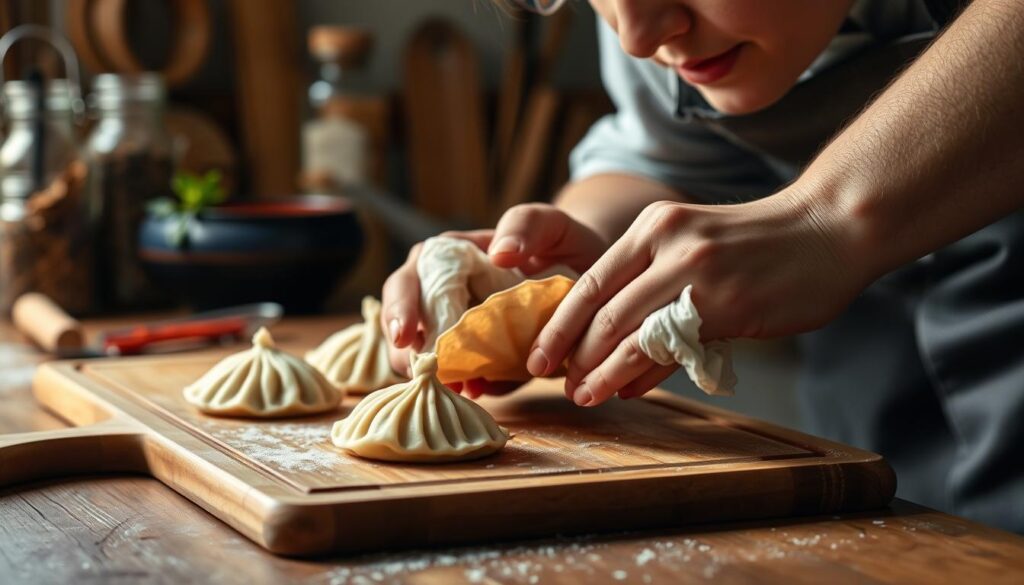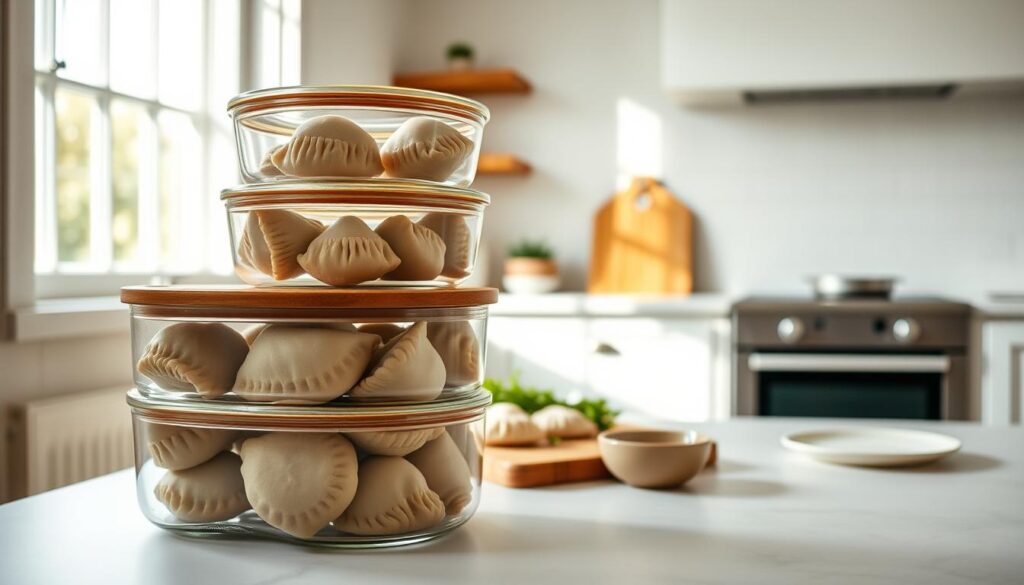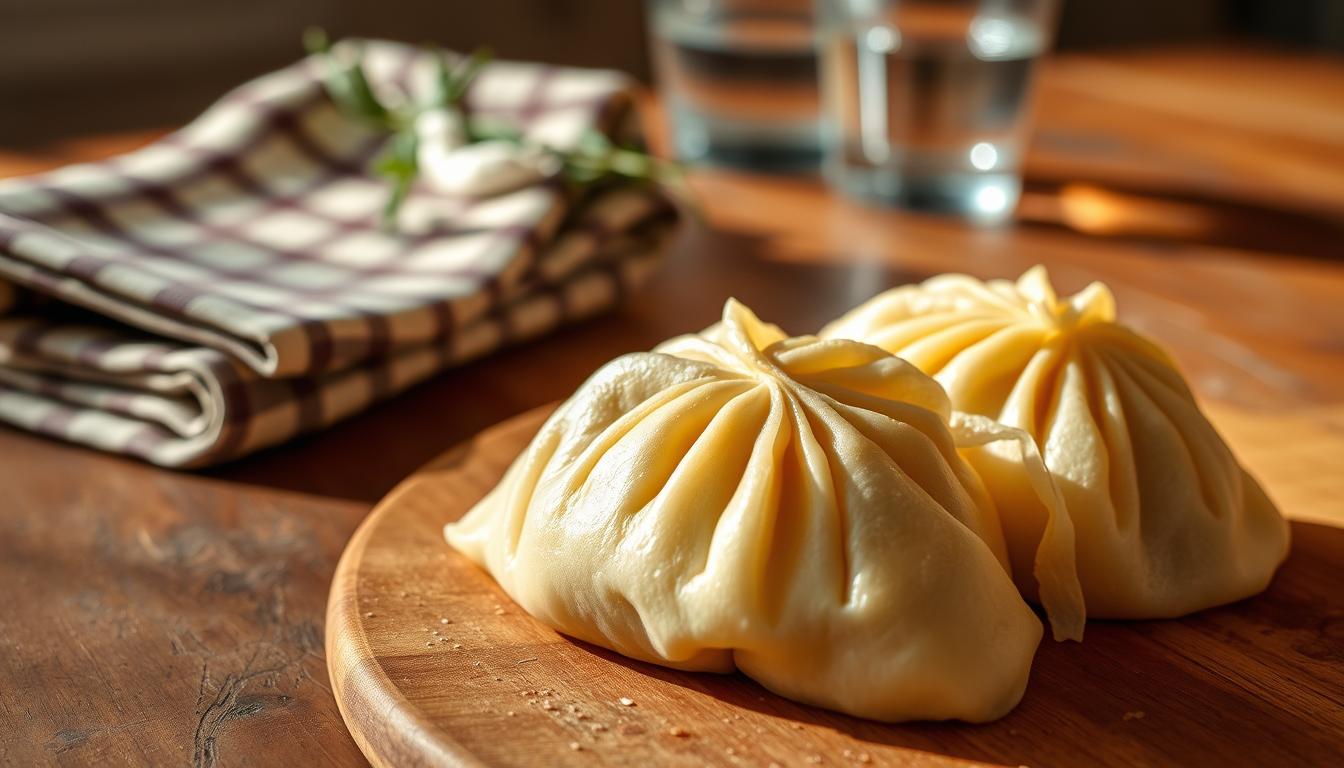Growing up in a small Yorkshire kitchen, I watched my grandmother make magic. She turned simple ingredients into warm, comforting parcels. These British dumplings are more than food; they’re a way to connect generations through taste and tradition.
A classic dumpling recipe is more than a side dish. It shows the deep roots of British home cooking. These dough balls, whether in a beef stew or with a Sunday roast, are true British comfort food.
Starting your journey to make authentic British dumplings is easy. These treats are simple to make but pack a big flavour punch. Whether you’re a home cook or a pro chef, you can learn this recipe that has been loved by British families for ages.
In this guide, you’ll learn the secrets to making perfect, fluffy dumplings. They’ll take you straight to a warm British kitchen. Get ready to explore a culinary tradition that has warmed hearts and filled bellies across the UK.
Table of Contents
The History of British Dumplings: From Medieval Times to Modern Tables
Dumplings have been a beloved part of British food for centuries. They have been shaped by regional cooking and social traditions. The story of dumplings in Britain is one of survival, creativity, and adapting to culture.
The start of these tasty treats goes back to medieval times. Back then, cooks made do with what little they had. As different areas developed, their own dumpling styles came to be.
Roots in Rural Cuisine
For working-class families, dumplings were a lifesaver. They were a filling, affordable meal that was easy to make. This made them perfect for farmers and labourers who worked long hours.
- Medieval origins in peasant cooking
- Developed from simple flour and water mixtures
- Designed to stretch limited food resources
Culinary Transformation
Over time, dumplings went from basic food to a favourite in British cuisine. Each region made its own version, using local ingredients and cooking ways.
| Region | Dumpling Characteristic |
|---|---|
| Yorkshire | Suet-based, robust texture |
| Scotland | Herb-infused variations |
| Cornwall | Lighter, more delicate style |
Cultural Significance
Now, dumplings mean more than just food. They connect us to our culinary past. From simple beginnings to today’s tables, they bring joy and nourishment.
Essential Ingredients for Perfect British Dumplings
Starting to make British dumplings means knowing the right dough ingredients. Your journey begins with picking top-quality flour. This is the base of these comforting treats.
The main ingredients for the dough are:
- Self-raising flour (essential for light texture)
- Suet or vegetable shortening
- Salt for seasoning
- Cold water or milk
Exploring fillings, British cuisine offers many tasty options. You can choose from classic meat mixtures to vegetarian choices that please everyone.
“The secret to perfect dumplings lies in the quality of your ingredients and the love you put into preparing them.” – Traditional British Cook
Here are some filling ideas:
- Minced beef with herbs
- Lamb and rosemary
- Vegetable medley with thyme
- Cheese and onion combinations
For lighter dumplings, try different flours or add herbs to the dough. Dumplings are versatile, allowing for creative cooking while keeping their traditional feel.
Getting the right texture is key. Make sure to measure your ingredients carefully. A mix of flour, fat, and liquid will make your dumplings light, fluffy, and tasty.
Classic British Dumpling Recipe: Step-by-Step Guide
Making the perfect dumpling recipe needs precision, patience, and creativity. British dumplings are a comfort food loved by many. They can turn any stew or soup into a satisfying meal. This guide will help you become a pro at making delicious dumplings, whether you’re new to cooking or have lots of experience.
To make exceptional dumplings, first learn the basic techniques and ingredients. The right way can change dense, heavy dumplings into light, fluffy ones.
Preparing the Dough
A great dumpling recipe starts with top-notch ingredients. You’ll need:
- Self-raising flour (200g)
- Suet (100g)
- Salt (pinch)
- Cold water
Achieving the Right Consistency
Mixing your ingredients needs a gentle touch. Put the flour, suet, and salt in a bowl. Gradually add cold water, mixing until the dough forms. Aim for a soft, pliable mix that’s not too sticky or dry.
Tips for Light and Fluffy Results
Shape variations can greatly affect your dumpling’s texture. Try these tips:
- Roll the dough gently to avoid overworking
- Create small, uniform balls for even cooking
- Leave space between dumplings when cooking
“The secret to perfect dumplings is in the handling – less is always more!” – Traditional British Chef
Experiment with different shapes to find your favourite. Whether round, oval, or irregular, each dumpling adds its own charm to your dish.
Traditional Cooking Methods and Techniques
Learning to cook British dumplings is all about mastering different techniques. These methods help bring out their unique flavours and textures. Each way of cooking has its own benefits for making delicious dumplings that go well with traditional British dishes.
Exploring cooking methods, you’ll find three main techniques for making dumplings:
- Boiling: The oldest method, boiling makes soft, tender dumplings great for stews and soups
- Steaming: This method creates lighter, fluffier dumplings with a soft texture
- Baking: It gives dumplings a crispy outside and a moist inside
Cooking times and temperatures are key to making perfect dumplings. Each cooking method changes the final result a lot.
| Cooking Method | Typical Cooking Time | Best Suited For |
|---|---|---|
| Boiling | 15-20 minutes | Stews and liquid-based dishes |
| Steaming | 10-15 minutes | Light, airy dumpling recipes |
| Baking | 20-25 minutes | Casseroles and dry heat dishes |
To cook like a true Brit, try adding dumplings straight to your stew or casserole. This way, they soak up all the flavours and keep their special texture.
Pro tip: Always make sure your dumpling dough is well-mixed and not overworked. This helps get the right consistency for all cooking methods.
Pairing Your Dumplings: Classic British Stews and Soups
Discovering the perfect match for your homemade dumplings can turn a simple meal into a feast. British cuisine has many hearty dishes that go well with dumplings. It’s about making a meal that pleases the senses.
Start your journey through traditional British pairings. Here, dumplings are the ultimate comfort food. It’s about how these dough balls work with different dishes, making them taste better.
Beef and Ale Stew Combinations
Beef and ale stews are the best match for dumplings. These strong dishes make a great base for soft, fluffy dumplings. Choose dipping sauces that match the bold flavours.
- Horseradish cream sauce
- Mustard-based dipping sauces
- Traditional gravy
Chicken and Vegetable Pairings
Chicken and vegetable dishes are lighter and perfect for dumplings. Dipping sauces can add a fresh touch. Try herb-infused sauces to highlight the dish’s flavours.
Traditional Sunday Roast Accompaniments
No British meal is complete without a Sunday roast. Dumplings with roasted meats make a comforting dish. Try herb-laden dipping sauces to add more flavour.
The secret to perfect dumplings lies not just in their preparation, but in their perfect pairing.
Common Mistakes to Avoid When Making Dumplings

Making the perfect dumplings needs skill and care. Many home cooks face problems that can ruin a dish. This can turn a tasty meal into a letdown.
Here are key mistakes to watch out for:
- Overmixing the dough – This makes dumplings tough and dense
- Using the wrong flour amounts
- Not mixing ingredients correctly
- Not keeping the dough at the right temperature
The biggest challenge is getting the right texture. Overworking the dough can make dumplings heavy and unappealing. Chefs say to mix ingredients gently.
Temperature is also key. Cold ingredients make dumplings flaky and tender. Make sure your butter or suet is cold before mixing it with dry ingredients.
Precision is key: treat your dumpling dough with gentle respect.
Seasoning is another common mistake. Dumplings can taste bland if not seasoned enough. Too much seasoning can hide the flavours of your stew or soup.
- Use fresh herbs
- Measure seasonings carefully
- Taste your mixture before cooking
Getting better at making dumplings takes practice. Each try teaches you more about making those light, fluffy treats that British food is famous for.
Modern Twists on Traditional British Dumplings
British dumplings are now in a new era of food innovation. Chefs and home cooks are making these classic dishes more exciting. They use creative vegetarian options and new fillings that keep the traditional taste but add a modern twist.
Today’s dumpling recipes are more versatile for different diets. The old suet-based recipe has been updated with new ingredients and cooking methods.
Vegetarian Adaptations
Vegetarian dumplings are getting more popular. They use meat substitutes that are full of nutrients. Here are some tasty filling ideas:
- Roasted butternut squash with sage
- Spinach and ricotta cheese
- Mushroom and thyme blend
- Lentil and root vegetable medley
Contemporary Flavour Additions
Modern British dumplings mix in global flavours. Try adding new spices and herbs to your old recipe.
| Flavour Profile | Recommended Ingredients |
|---|---|
| Mediterranean | Sun-dried tomatoes, oregano, feta cheese |
| Asian-Inspired | Ginger, spring onions, soy sauce |
| Indian Fusion | Cumin, turmeric, coriander |
Gluten-Free Options
If you’re gluten-sensitive, there are great alternatives. Gluten-free flour blends from rice, corn, or chickpea flour taste and feel great.
- Replace wheat flour with gluten-free alternatives
- Use xanthan gum for binding
- Experiment with different flour combinations
By trying these new ideas, you can make traditional British dumplings into something exciting. They’ll be loved by everyone, no matter their diet.
Storage and Reheating Guidelines

Keeping your homemade dumplings fresh needs careful steps. Knowing how to store and reheat them is key. This way, you can enjoy their soft texture and tasty flavour for longer.
Here’s how to store cooked dumplings:
- Refrigerate in an airtight container within two hours of cooking
- Store for maximum three days in the refrigerator
- Use shallow containers to promote even cooling
Freezing is a great way to keep dumplings for longer. Uncooked dumplings freeze well. Wrap each one in parchment paper and then in freezer bags to stop them sticking together.
Reheating should be done gently to keep them moist. Here are some good ways to do it:
- Steaming: Ideal for maintaining softness
- Oven warming: Use low temperature (around 150°C)
- Microwave: Short bursts with a damp kitchen towel
Pro tip: Always check internal temperature reaches 74°C to ensure food safety when reheating dumplings.
Frozen uncooked dumplings can be added straight to stews or soups. This makes them even more versatile in your cooking.
Conclusion
Your journey through British dumplings has shown us a long history. These dishes have been around for centuries, from medieval times to today. They are more than just food; they are a symbol of British culture and creativity in the kitchen.
This guide has given you a peek into British cuisine’s depth. You’ve seen how different parts of the UK have their own dumpling styles. Whether you’re making beef stew in Yorkshire or vegetable soup in Cornwall, dumplings add warmth and comfort to any meal.
Making dumplings is all about being creative in the kitchen. You can change old recipes to fit your tastes, try new flavours, and connect with a long tradition. Every dumpling you make tells a story of British food history, mixing old ways with new ideas.
Your adventure with British dumplings is just the start. It’s a chance to keep learning, cooking, and celebrating the UK’s food heritage. Let your kitchen be a place where you tell stories through food.

